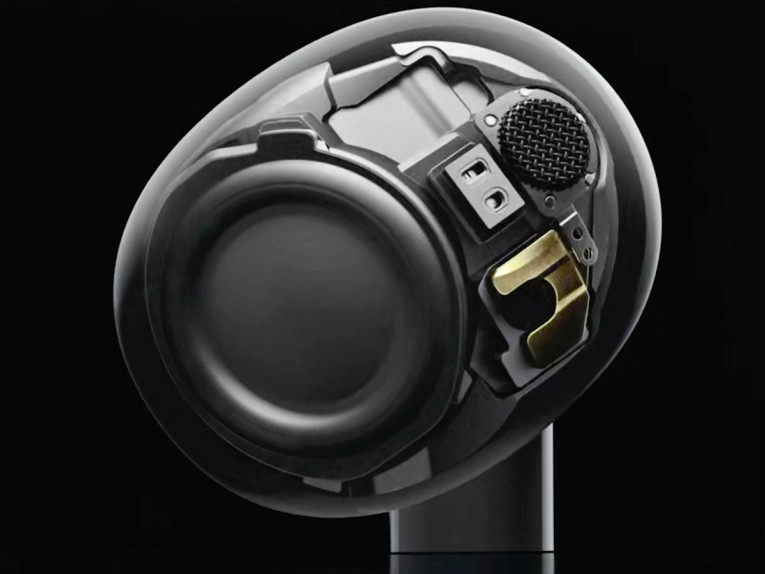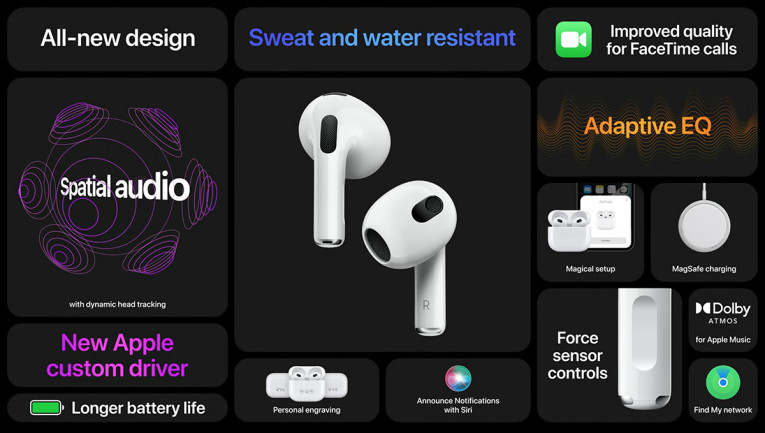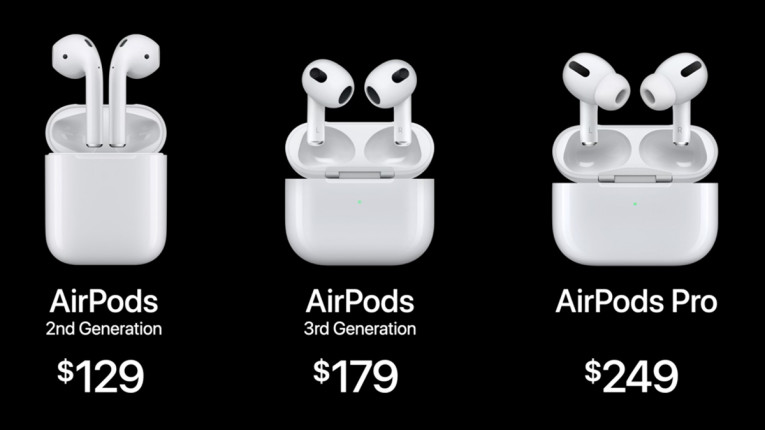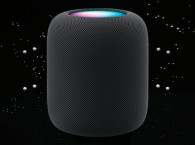
The third-generation Apple AirPods, which are the best-selling loose-fit, true wireless earbuds globally, received a significant ergonomic and driver design which will greatly improve the user experience, help support better communication and now also support Spatial Audio, which Apple is promoting as a major differentiator. This means support for Dolby Atmos in Apple Music, movies, and TV shows, along with dynamic head tracking, across Apple devices.
While these standard AirPods don’t feature Active Noise Cancellation (ANC) like the more expensive in-ears AirPods Pro - those will be updated probably only mid 2022 - they also gained some additional processing capabilities (computational audio in Apple’s terms) which will no doubt improve greatly the user experience. By combining the power of the H1 chip with an Apple-designed acoustic system, the new earbuds allow personalization and Adaptive EQ - and there will be room for firmware updates in the future. These third-generation AirPods also improve the earbuds battery for 6 hours of playtime (an extra hour of battery life), while the 30 hours case now supports fast charging and magnetic contact charging (MagSafe).
Front and center, the new AirPods feature an all-new design, with a shorter stem. And that’s a big deal given the popularity of the previous - and copiously copied - EarPods and AirPods. The most strange thing is the fact that this new design was leaked long ago, and that explains why it already looks familiar. And yet, the new contoured design is now going to be the new loose-fit standard. The new AirPods are obviously resistant to sweat and water, and feature a force sensor (borrowed also from the AirPods Pro) for easy and intuitive control of music and phone calls.

Internally, the AirPods (3rd generation) received a new custom driver and a high dynamic range amplifier, and the microphone is covered by an acoustic mesh to help reduce the sound of wind, particularly important since this new design now features AAC-ELD, a superior speech codec that offers full HD voice quality - highly noticeable in natural communication for FaceTime calls.
Overall it might not seem much, given the amount of features that we see being advertised all the time by other manufacturers with every new model of TWS earbuds. But the reality is that these third-generation AirPods have exactly the right balance of features that users will care about, and they will once again set the standard - in volumes. And even if $179 might sound steep, comparing with the much cheaper alternatives with ANC now in the market, Apple has reasons to be relatively confident in the category.
As Apple details, the new AirPods feature Adaptive EQ that tunes sound in real time based on how AirPods fit in the user’s ear. An inward-facing microphone monitors for sound, and then Adaptive EQ, powered by computational audio, tunes the low and mid frequencies to account for what may be lost due to variances in fit. And the beamforming microphones are able to block out ambient noise and focus on the user’s voice during calls and an essential feature for hands-free “Hey Siri” voice requests. Add to this the computational power provided for advanced spatial audio algorithms, and there’s reasons to believe this same design will eventually support audio enhancement features - if not noise cancellation.

And Apple is clearly aware of the potential of Siri in true wireless earbuds, which many users prefer for notifications. Instead of saying voice commands out-loud, which is not even practical in most situations, being a connected assistant, Siri is able to read important time-sensitive notifications, including alerts from Messages, Reminders, Calendar, and calls. More importantly, any third-party apps that adopt the API can also create “whisper-in-my-ear” advice, offer confidential instructions, or even provide entertaining talk.
Probably more crucial for regular users now, is the one-touch setup experience that automatically pairs AirPods with other Apple devices. Audio Sharing also allows listeners to share the audio stream between two sets of AirPods, AirPods Pro, or AirPods Max, while using iPhone, iPad, iPod touch, or Apple TV.

Apple also details that, thanks to the latest iOS 15 and iPadOS 15 updates, users can also enjoy the improved voice directionality available during a Group FaceTime. AirPods are also now part of the Find My network of hundreds of millions of iPhone, iPad, and Mac computers around the world, offering proximity view in the Find My app and Lost Mode, as well as separation alerts and sounds. Those are compelling arguments. And just in case, the “old” 2nd generation AirPods will remain available at the new lower price of $129 (US).

For those concerned with eco-credentials, Apple made clear that the new AirPods reduce their environmental impact, including the 100 percent recycled rare earth elements used in all magnets. The case also uses 100 percent recycled tin in the solder of the main logic board, and 100 percent recycled aluminum in the hinge. For energy efficiency, AirPods meet US Department of Energy requirements for battery charger systems. Apple’s Zero Waste program helps suppliers eliminate waste sent to landfills, and all final assembly supplier sites are transitioning to 100 percent renewable energy for Apple production. In the packaging, 100 percent of the virgin wood fiber comes from responsibly managed forests.

More Audio Announcements
During the streamed event - focused on the new flagship MacBook Pro laptops - Apple also made another interesting audio-related announcement. A new Apple Music Voice Plan, which restricts access to the Apple Music catalog through Siri voice recognition, will be available later this fall in select countries and regions for $4.99 (US) per month.
The new Apple Music Voice Plan is particularly intriguing giving that voice commands for music requests are one of the most challenging and sensitive for voice recognition engines. And considering that, included in the initial 17 countries and regions, apart from the United Kingdom, and the United States, are Australia, Austria, Canada, China, France, Germany, Hong Kong, India, Ireland, Italy, Japan, Mexico, New Zealand, Spain, and Taiwan.
Good luck asking anyone from different regions of Italy or Spain to say the names of popular artists and albums. What Apple expects is that most requests from young users will remain mainstream sentences 100% in English, such as: “Hey Siri, Play Happier Than Ever by Billie Eilish…” And of course, Apple also expects 98% of users to simply say: “Hey Siri, Play New Music,” or “Play Something Chill.” (Reproduci qualcosa di tranquillo - as Google translated to Italian, is not something that Siri will expect).

The main motivation might be to offer a new Apple Music subscription tier for just $4.99 per month (it doesn’t include Spatial Audio and Lossless Audio, Lyrics, or Music Videos). Offering a full-service “designed exclusively for Siri” is a bold experiment for Apple, particularly since it will be available this fall already in multiple languages. And even the subscription can be activated through Siri by saying, “Hey Siri, start my Apple Music Voice trial” (just in case, users can sign up through the Apple Music app).
Explaining the “effortless” strategy, Oliver Schusser, Apple’s vice president of Apple Music and Beats states that “Apple Music and Siri are natural partners and already work seamlessly together. With Siri actively used on hundreds of millions of devices worldwide, we are thrilled to add this new plan that delivers an effortless music experience just by using your voice and makes Apple Music accessible to even more people around the world.”
Apple Music Voice Plan subscribers will get a customized in-app experience with suggestions based on the listener’s music preferences and a queue of recently played music through Siri. Within the app there will also be a dedicated section called “Just Ask Siri” where subscribers can learn tips to optimize Siri for Apple Music. This might be a great marketing idea to promote Siri - or improve Siri - or maybe not.
www.apple.com







